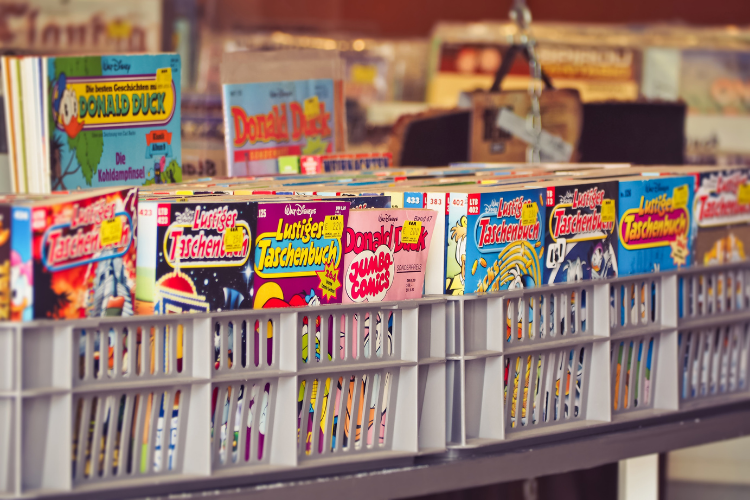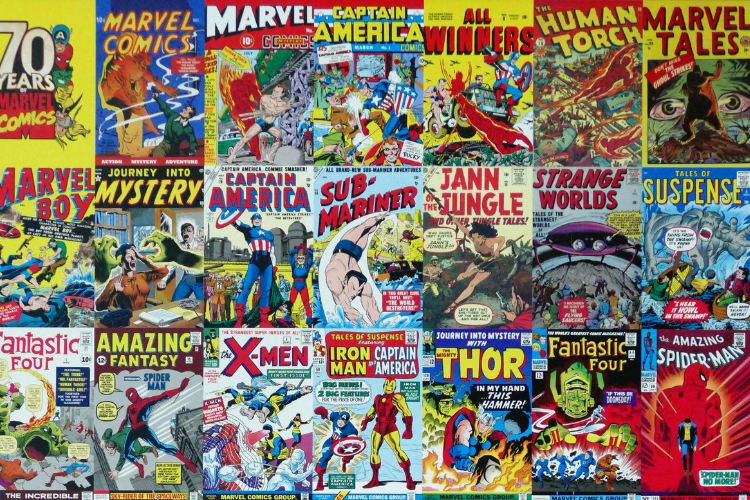- The Best Iron Man Costume Ideas for Halloween and Cosplay - September 12, 2022
- Common Comic Book Terms and Phrases Explained - February 7, 2022
New to the comic book sphere? You may have noticed all the comic book jargon tossed around, which isn’t very helpful if you don’t know what comic book-related terms mean. That’s why I’ve composed this guide to walk you through all the need-to-know terms for next time you hit up the comic book store. I hope you’re ready because we’ve got a lot of ground to cover.
Production
Producing a comic book is not a single-person effort. Often, it takes a team of 6 or more people just to get the story and art all finished.
- Writer: This is the story’s creator who comes up with the characters and writes the dialogue. They decide how the story will unfold.
- Penciler: A penciler is a person who comes up with all the character designs and original artwork. As their name implies, they draw out the story in pencil.
- Inker: Inkers add detail and polish to the artwork the penciler made. They clean up the pencil lines by tracing over them with a pen or tracing the lines digitally.
- Colorist: This person gets to add color and greater depth to the artwork. They decide the color schemes. Nowadays, almost every colorist is doing their work digitally.
- Letterer: How did that thought bubble get there? It was the letterer! Letterers place the dialogue and thoughts in the correct bubbles and decide where those bubbles go on the page. They also design the sound effects.
- Editor: This is the person that looks over the work that everyone else did and checks it for any mistakes. The editor is also responsible for making sure none of the comic has been plagiarized or directly correlates to someone else’s work.
Editions
“Edition” refers to the format comic books come out in. Some are longer or shorter, paperback or hardcover. I’ll explain it all.
- Single Issue: These comics usually have between 20-35 pages. They’re released chronologically on a schedule to tell the whole story of a comic series.
- Prestige Edition: These comics are typically longer than single-issue comics being between 45-65 pages.
- Digital Comics: You can read some comics on your computer, tablet, phone, or other electronics. These are digital comics.
- Digital First: Some comics are released digitally before they’re ever put in print. In this case, the comic is considered a digital-first.
- Collected Edition: If you don’t want to buy every individual issue to get the whole story, buy a collected edition. These contain an entire comic story all in one book.
See also: Spiderman Characters Guide
Some examples of collected editions are:
- Trade Paperback: This is a paperback collected edition that usually has between 5-8 issues in a series
- Digest: This is a traditionally small collected edition.
- Hardcover: These usually contain around 12 single issues in one hardcover book.
- Omnibus: An omnibus is a huge hardcover collected edition that contains even more single issues than a hardcover. There can be over 25 single issues in one.
- Graphic Novel: Any comic book bound like a traditional book is considered a graphic novel.
- Original Graphic Novel: These comic books never came out in a sequence of single issues. Instead, they first come out in a paperback or hardcover book containing multiple issues.
Covers and Publications
Knowing cover and publication terms will make it easier to browse comics for the particular one you want. Here are the key definitions to know.
- Variant Cover: Usually rarer than the standard single issue, variant covers feature different cover art than what’s featured on the standard issue.
- Incentive Cover: If a comic book retailer wants to sell 1 variant cover issue, they may have to buy 10, 50, or more copies of the standard cover.
- Limited Series/Mini-Series: Usually 6 issues in length, only so many of these are ever released. Some have become very valuable with their rarity.
- Maxi-Series: Generally, maxi-series are at least 12 issues long, but they can be longer or shorter than that.
- Annual: This large comic special gives bonus content for the main storyline.
- One-Shot: The entire story wraps up in 1 issue, in a one-shot.
- Webcomic: Any comic that was made to be viewed on the internet is a webcomic.
- Mini-Comic: These comics are handmade most of the time. They’re smaller than usual comic books and have distinctly small print.
- Zine: This is another popular type of handmade comic book.
- Floppies: Sometimes, this is what we call the single issue paperback copies. You know, because they’re floppy.
See also: Wandavision Characters Guide
Conditions
The condition of a comic book can determine how valuable it is. When it comes to reselling comics you have and buying rare ones you don’t, knowing the condition terms is crucial to make sure you understand the pricing.
- Mint Condition: The comic book is in 100% perfect condition, like it was brand new.
- Near Mint: Maybe there’s a single tiny scratch or something, but near mint means the comic is in almost perfect condition.
- Very Fine: This is still a pretty great rating. Very fine means there will be some very minor damages to the comic book.
- Fine: Picture a very fine comic with just the tiniest bit more damage. Maybe there’s a tiny rip in the corner or someone dog-eared some pages.
- Very Good: This rating means that it is obvious someone else has read this comic before.
- Good: There is obvious wear and tear to a good-rated comic that some might find distracting.
- Fair: You can read most of it. Most of it.
- Poor: Most of the time, this beat-up, barely legible comic isn’t worth the purchase.
- Key Issue: These are the most popular issues in a series. Generally, if a main or major character dies, gets married, does something really cool, kills someone powerful in a fight, etc., it could be a key issue.
Interior
Unsure about the terms for what’s going on in a comic page? These are 3 important terms to know.
- Panel: This is a box with pictures or words in it on the page.
- Slash: When 1 panel takes up an entire page of its own, it’s called a slash panel.
- Two-Page Spread: This refers to when 1 panel takes up 2 side-by-side pages.
Other Types and Terms
There are numerous other commonly-used words to remember so you keep up in the fast-paced world of comic book buying. These are the most important ones.
- Manga: These are comics that come from Japan and should be read from right to left.
- Manhwa: Comics that come from Korea are called manhwas.
- Anthology: Several creators make up several different short stories to create an anthology.
- Zero Issue: This issue acts as a prequel or prelude to the first issue in a series. This issue comes out sometime after the first issue has been released.
- Creator-Owned: This means the publisher does not own the rights to the story or characters, only the creator does.
- Solicitations: This is a page that lists out all the upcoming comic book releases that are published under one publisher.
- Indie: Publishers who work independently from large companies are called indie publishers.
- Continuity: This means that characters have an ongoing plot told across many different comic book series. Think about how Iron Man exists in many series of Marvel comics.
- Retcon: When comic creators and publishers decide they no longer want an event from a characters’ past to be part of their true canon story, they can change that past event and say something else happened to the character instead.
- Crossover: When characters and plotlines from different comics come together to create a new series, we call it a crossover.
- Event: This is a larger-scale crossover where the story is usually always meant to be taken as canon.
- Pre-Flashpoint: When DC retconned a ton of character events and updated how their characters looked, they retconned a bunch of past events in 1985-1986.
- Back-Issue: This refer to any comic issue that isn’t the latest issue.
- Back-Up Feature: You can sometimes find these in the back of an issue. They give writers a chance to try new plotlines, new characters, and secondary characters to see how the audience reacts.
- LCS: This simply means “local comic store.”
- Run: If comics in a series are consecutively published, it’s called a run.
- Off-Panel: Anything that happens behind-the-scenes (or not visible in the panels) during comic book creation and publishing.
- Onomatopoeia: These are the sound effects in big letters, like “POW!”
- Comixology: You can find tons of digital comics on this app that functions as an online marketplace.
- Story Arc: Story arcs are plotlines told in full across several or many different issues.
- Diamond: This is the name of the biggest distributor of graphic novels and comic books.
Turning the Last Page
I hope you feel better informed about comic book terminology! If you have anyquestions, please leave them in the comments below, and I’ll do my best to answer them. For more great comic book info, come check out our website!
Recommended Reads:




